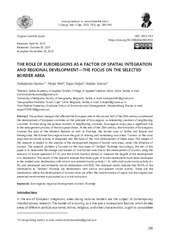Приказ основних података о документу
The Role of Euroregions as a Factor of Spatial Integration and Regional Development—The Focus on the Selected Border Area
| dc.creator | Stankov, Slobodanka | |
| dc.creator | Perić, Marija | |
| dc.creator | Doljak, Dejan | |
| dc.creator | Vukovic, Natalia | |
| dc.date.accessioned | 2023-11-12T11:30:16Z | |
| dc.date.available | 2023-11-12T11:30:16Z | |
| dc.date.issued | 2021 | |
| dc.identifier.issn | 0350-7599 (Print) | |
| dc.identifier.issn | 1821-2808 (Online) | |
| dc.identifier.uri | https://dais.sanu.ac.rs/123456789/15413 | |
| dc.description.abstract | The political changes that affected the European area in the second half of the 20th century conditioned the development of European countries on the principle of Euroregions, as interesting creations of neighboring countries. Formed along the political borders of neighboring countries, Euroregions today play a significant role in the enlargement process of the European Union. At the end of the 20th century, the formation of Euroregions covered the area of the Western Balkans as well. In Podrinje, the border area of Serbia and Bosnia and Herzegovina, the formed Euroregions have the goal of reviving and revitalizing rural areas. Tourism, as the most important economic activity, is integrated into the basis of the rural development of these areas. The subject of the research is related to the analysis of the development degree of border rural areas, under the influence of tourism. The research problem is focused on the rural areas of “Serbian” Podrinje. Accordingly, the aim of this paper is to determine the change and burden of rural border area due to the development of tourism, using the indicator of tourist operation (I.T.O.) and the tourist function indices to measure the degree of the development of a destination. The results of the research indicate that three types of tourist destinations have been developed in the studied area: destinations with almost non-existent tourist activity (< 4), with small-scale tourist activity (410), and developed and eminently tourist destinations (40–100). The obtained results indicate that 83.3% of the destinations in "Serbian" Podrinje are destinations with almost non-existent tourist activity. These are the destinations where the development of tourism does not affect the transformation of space, but the original and preserved environment is promoted as a tourist attraction. | sr |
| dc.language.iso | en | sr |
| dc.publisher | Belgrade : Geographical Institute “Jovan Cvijić” SASA | sr |
| dc.relation | info:eu-repo/grantAgreement/MESTD/inst-2020/200172/RS// | sr |
| dc.rights | openAccess | sr |
| dc.rights.uri | https://creativecommons.org/licenses/by-nc-nd/4.0/ | |
| dc.source | Journal of the Geographical Institute “Jovan Cvijić” SASA | sr |
| dc.subject | Euroregions | sr |
| dc.subject | regional development | sr |
| dc.subject | tourism | sr |
| dc.subject | Podrinje | sr |
| dc.title | The Role of Euroregions as a Factor of Spatial Integration and Regional Development—The Focus on the Selected Border Area | sr |
| dc.type | article | sr |
| dc.rights.license | BY-NC-ND | sr |
| dc.citation.spage | 295 | |
| dc.citation.epage | 310 | |
| dc.citation.volume | 71 | |
| dc.citation.issue | 3 | |
| dc.identifier.wos | 000756850000006 | |
| dc.identifier.doi | 10.2298/IJGI2103295S | |
| dc.identifier.scopus | 2-s2.0-85125859205 | |
| dc.type.version | publishedVersion | sr |
| dc.identifier.fulltext | http://dais.sanu.ac.rs/bitstream/id/61668/bitstream_61668.pdf | |
| dc.identifier.rcub | https://hdl.handle.net/21.15107/rcub_dais_15413 |

